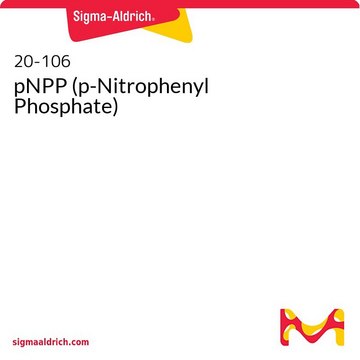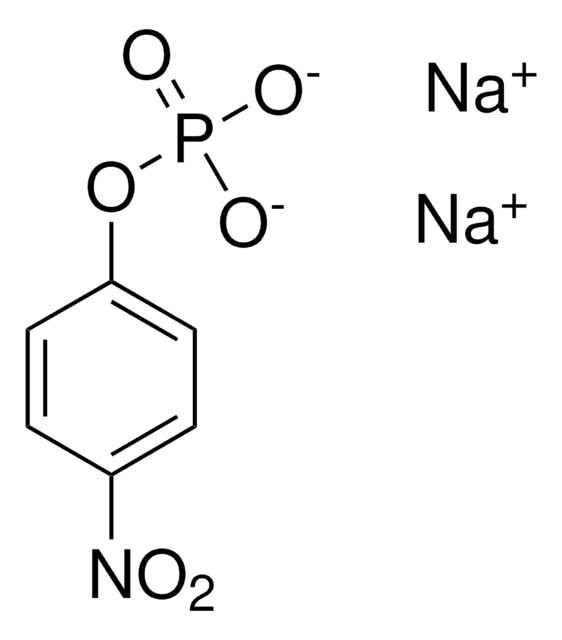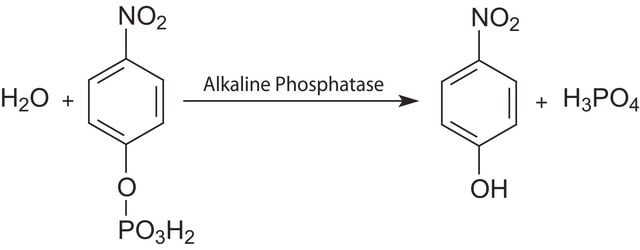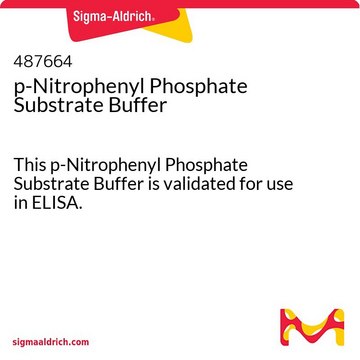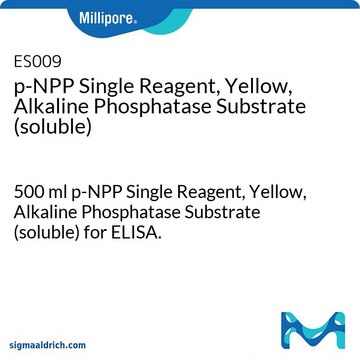487663
p-Nitrophenyl Phosphate
This p-Nitrophenyl Phosphate is validated for use in ELISA.
Sinonimo/i:
Phosphate Ester, p-Nitrophenyl Ester
Autenticatiper visualizzare i prezzi riservati alla tua organizzazione & contrattuali
About This Item
Codice UNSPSC:
41116158
NACRES:
NA.25
Prodotti consigliati
Livello qualitativo
Stato
liquid
non contiene
preservative
Produttore/marchio commerciale
Calbiochem®
Condizioni di stoccaggio
OK to freeze
protect from light
Colore
clearslightly yellow tint
Condizioni di spedizione
ambient
Temperatura di conservazione
2-8°C
Descrizione generale
p-Nitrophenyl phosphate is the most common substrate for alkaline phosphatase-based ELISA assays. Hydrolysis of the phosphate ester liberates p-nitrophenol, a soluble, yellow chromogen that can be measured spectrophotometrically at 405 nm (ε = 1.83 x 104 M-1cm-1). As the reaction is linear, kinetic assays can be performed. Endpoint determinations can also be performed by stopping the reaction with strong base and measuring the absorbance at 405 nm. This p-NPP preparation is a stable, convenient, liquid concentrate in a proprietary solvent.
p-Nitrophenyl phosphate supplied as a 50X concentrate (0.19 mol/l). For use with p-NPP Substrate Buffer, Cat. No. 487664.
Excellent substrate for alkaline phosphatase-based ELISA assays. Produces yellow soluble end product that can be read at 405 nm to 410 nm. Both kinetic and endpoint determinations can be performed. Supplied as ready-to-use. A ready-to-use diluent is available separately (Cat. No. 487664).
This p-Nitrophenyl Phosphate is validated for use in ELISA.
Applicazioni
ELISA
Azioni biochim/fisiol
Primary Target
Substrate for alkaline phosphatase-based ELISA assays
Substrate for alkaline phosphatase-based ELISA assays
Product does not compete with ATP.
Attenzione
Toxicity: Standard Handling (A)
Stato fisico
Supplied as a 50X concentrate.
Ricostituzione
Discard if solution turns bright yellow or becomes turbid.
Altre note
Functionality check performed on the final product in ELISA.
Suggested procedure for use of p-NPP in alkaline phosphatase-based ELISAs:
1. Prepare 1X p-NPP Substrate Solution: To 39 parts dH2O add 1 part 50X p-NPP Concentrate and 10 parts p-NPP Substrate Buffer (Cat. No. 487664). Mix well and store protected from light. This diluted reagent is suitable for up to 10 h after preparation.
Note: Cat. No. 487664 is an AMP (2-amino-2-methyl-1-propanol)-based buffer. Other buffers, e.g. diethanolamine (DEA)-based and 2-amino-2-methyl-1,3-propanediol (AMPD)-based, may also be employed.
2. Complete all required incubations with antibodies and alkaline phosphatase-labeled probes.
3. Wash plate wells at least 4 times with Tris-buffered saline (TBS) containing 0.1% Tween®-20 detergent. DO NOT USE PHOSPHATE BUFFERS; inorganic phosphate is a potent inhibitor of alkaline phosphatase.
4. After the final wash, shake and blot all residual buffer from the wells.
5. Add 100 µl of 1X p-NPP Substrate Solution (prepared in Step 2) to each well and incubate for 15-60 min. (If a kinetic study is desired, readings at 405 nm may be taken at intermediate intervals).
[Note: Optimal incubation times may vary depending on the amount of enzyme present. If color develops too quickly, dilution of the probe, antibody, or alkaline phosphatase-labeled reagent may be required.]
6. Stop the reaction by adding 100 µl 1 N NaOH.
7. Read absorbance at 405 nm.
Note: Variations in time, reagent volumes, and temperature may require further standardization by the user.
Suggested procedure for use of p-NPP in alkaline phosphatase-based ELISAs:
1. Prepare 1X p-NPP Substrate Solution: To 39 parts dH2O add 1 part 50X p-NPP Concentrate and 10 parts p-NPP Substrate Buffer (Cat. No. 487664). Mix well and store protected from light. This diluted reagent is suitable for up to 10 h after preparation.
Note: Cat. No. 487664 is an AMP (2-amino-2-methyl-1-propanol)-based buffer. Other buffers, e.g. diethanolamine (DEA)-based and 2-amino-2-methyl-1,3-propanediol (AMPD)-based, may also be employed.
2. Complete all required incubations with antibodies and alkaline phosphatase-labeled probes.
3. Wash plate wells at least 4 times with Tris-buffered saline (TBS) containing 0.1% Tween®-20 detergent. DO NOT USE PHOSPHATE BUFFERS; inorganic phosphate is a potent inhibitor of alkaline phosphatase.
4. After the final wash, shake and blot all residual buffer from the wells.
5. Add 100 µl of 1X p-NPP Substrate Solution (prepared in Step 2) to each well and incubate for 15-60 min. (If a kinetic study is desired, readings at 405 nm may be taken at intermediate intervals).
[Note: Optimal incubation times may vary depending on the amount of enzyme present. If color develops too quickly, dilution of the probe, antibody, or alkaline phosphatase-labeled reagent may be required.]
6. Stop the reaction by adding 100 µl 1 N NaOH.
7. Read absorbance at 405 nm.
Note: Variations in time, reagent volumes, and temperature may require further standardization by the user.
Note legali
CALBIOCHEM is a registered trademark of Merck KGaA, Darmstadt, Germany
TWEEN is a registered trademark of Croda International PLC
Codice della classe di stoccaggio
12 - Non Combustible Liquids
Classe di pericolosità dell'acqua (WGK)
WGK 3
Punto d’infiammabilità (°F)
Not applicable
Punto d’infiammabilità (°C)
Not applicable
Certificati d'analisi (COA)
Cerca il Certificati d'analisi (COA) digitando il numero di lotto/batch corrispondente. I numeri di lotto o di batch sono stampati sull'etichetta dei prodotti dopo la parola ‘Lotto’ o ‘Batch’.
Possiedi già questo prodotto?
I documenti relativi ai prodotti acquistati recentemente sono disponibili nell’Archivio dei documenti.
I clienti hanno visto anche
Il team dei nostri ricercatori vanta grande esperienza in tutte le aree della ricerca quali Life Science, scienza dei materiali, sintesi chimica, cromatografia, discipline analitiche, ecc..
Contatta l'Assistenza Tecnica.